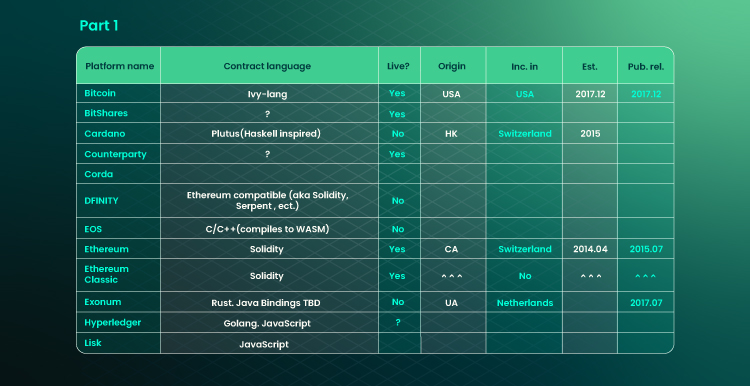Unique in its own right, blockchain has brought to life a lot of new mechanisms that can be used far beyond transaction-based constraints. Today, with smart contracts in the foundation, entire business technologies are being created for various commercial enterprises, the technical community, and the average consumer. This is widely employed to gain a competitive edge.
At Forbytes, we provide up-to-date software solutions for clients from across industries and niches. This gives us enough hands-on experience and expertise in the existing smart contract mechanisms and solutions to share with you. Let’s start from the top.
What Is a Smart Contract?
A smart contract is a computer algorithm designed to automatically manage the transfer of information about the ownership of assets between two or more parties after certain conditions are met. In a narrower sense, it is a set of functions and data (current state) located at a specific address in the blockchain.
Frankly speaking, any piece of code in the blockchain that can manage assets (cryptocurrency) within the same blockchain can be safely deemed a smart contract. To be considered a full-on smart contract, however, it must be automatic, traceable, immutable, and irreversible.
On top of that, such a code is used to modernize traditional legal contracts. These improvements may take the form of more stable or predictable conventions or simplify complex operations. However they are not yet supported by the legislative framework of most communities and do not yet have legal force.
How does a smart contract work in a nutshell?
- Assets are coded;
- Contract conditions are coded;
- Assets and conditions are introduced to a blockchain as one block;
- As soon as the conditions are met by both parties of the transaction, all asset transfers are carried out accordingly.
Benefits of Using Smart Contracts Across Industries
Smart contracts are becoming an ideal solution for streamlining and automating transactions in any professional sector. They provide maximum transparency of transactions because they are immutable, that is, no one can change the contract in order to gain advantages over other involved parties.
In real estate
In this extremely active field, smart contracts automate lease agreements, reducing the need for personal contacts and agreements. They can also help streamline processes such as property search and leasing or cash flow management.
Conditions can be negotiated before introducing the code. The terms of term deposits are set at the beginning of the contract, so at the end of the lease, any debts and balances are automatically taken into account.
In supply chain management
Digital asset management tools are often too expensive and require a lot of work, such as package scanning, bookkeeping, and paying bills. This is where you especially need to consider smart contract use cases.
ShipChain and VeChain are two projects that are working on smoothing out that functionality to supply chain management. The first is aimed at improving the tracking of goods and maximizing the efficiency of transport routes using blockchain technology. The second enhances security by using a custom fraud prevention infrastructure.
In financial sector
The smart contract platform is able to offer many useful applications for banks if the latter determines how to effectively coordinate legal contracts in this format. This will likely require banks to implement smart contracts that will align with both the development of blockchain infrastructure and legacy financial services infrastructure.
This could eliminate the delays typically caused by centralized institutions and allow automatic payments of fixed currencies from bank accounts to be triggered upon contract fulfillment. Similarly, these same contracts can ensure that relevant reports are automatically sent to the tax authorities.
In government institutions
Smart contracts can help solve tasks such as public procurement management and voting. Blockchain can be used to record promises made by public figures and then use that data to ensure that they are kept. Decentralized technologies can also be used to facilitate access to an anonymous voting register that citizens can easily access.
In healthcare
Blockchains can be used to store a variety of health data in a way that is accurate, fully encrypted, and digitally signed. Patients are enabled to choose who is allowed to access their medical information. And health care providers get to instantly share reliable, accurate health data with insurers or other healthcare providers.
Top 10 Smart Contracts Out There
To date, many development opportunities have been created, each of which has both positive and negative sides. Let’s take a look at today’s top smart contract platforms to give you a wider picture of the situation.
Ethereum
This is the first blockchain system that initiated the creation of smart contracts. It is perhaps the most reliable benchmark in terms of capitalization. Its advantage is the highest degree of standardization and support. Ethereum offers a set of clear rules that developers must follow to make development easier and less risky. It has its programming language, Solidity, which helps with standardization and greatly simplifies contract customization.
However, there are several security issues with the code. Also, the lack of platform scalability leads to low transaction speed. The Solidity language lacks flexibility. It does not support multidimensional arrays, and only a small number of parameters are allowed in the contract function, which greatly affects development methods.
Hyperledger Fabric
This is the basis for creating smart contracts targeted at large businesses. The platform provides the ability to create multi-layer configurations of the blockchain network. It uses its special language – Go, which is characterized by fast compilation, granting comfortable conditions for creating chain codes.
A set of extremely useful Javascript-based tools makes it much easier and more efficient to create contracts by simply installing the appropriate modules. At the same time, all network participants have known identification data. The existence of private channels allows you to increase reliability and throughput. However Hyperledger does not have its token system.
EOS
The algorithm allows you to boost the speed of transactions and block creation without compromising the decentralized structure, thanks to the Delegated-Proof-of-Stake (DPoS) consensus mechanism.
The WebAssembly virtual machine speeds up loading, parsing, and contract execution, and also allows you to use any programming language. A system of 21 privileged accounts allows you to send transactions directly to these accounts. This is how the “Byzantine Generals Challenge” is solved, and privileged accounts are selected from the general pool in the voting process.
All user transactions are required to contain the hash of the last known block so that the transaction never gets into a parallel chain (fork).
Stellar
Stellar smart contracts are not Turing-complete, which means that they are only meant for simple functions in basic applications. However, it is the simplest, least time-consuming solution. The code can be written in any language for which the Stellar community provides an API.
It features an accelerated transaction confirmation system: the whole process takes about 5 seconds (for comparison, Ethereum makes it 3.5 minutes). Plus, developers indicate an incredibly low transaction cost – users must pay only 1 cent for 100 thousand transactions.
NEO
The platform employs a decentralized Byzantine Fault Tolerance (dFBT) consensus algorithm. This mechanism has proven to be more energy-efficient, allowing transactions to be made much faster.
The protocol provides for participation in the consensus of several delegates, called bookkeepers, who are chosen by token holders. They support the network by confirming transactions, and their digital identities are known to network participants. To reach a consensus, 66% of bookkeepers must come to it. Thanks to this, the network works faster and more efficiently, but this protocol cannot be considered decentralized.
NEM
One of the key advantages of the platform is the high network scalability. Blockchain can process up to 4 thousand transactions per second.
NEM is more secure and easier to use than Ethereum and offers more options for programming and running dApps. But NEM works directly with the blockchain code, which makes the platform less decentralized. However, this method has many advantages in terms of high security, easy upgrades, high transaction speeds, and lighter code.
Free TON
Almost every element (including user wallets) is a smart contract on the blockchain. But this mechanism makes interactions between them asynchronous, which is important to ensure performance.
An important element is its operating system, which is a middleware interface between the network and users. Various tools are available for developing applications for it – for example, compilers with Solidity and C++, databases, and SDKs. All components are open-source software. For developers, a special site is also open with detailed documentation on all components.
Cosmos
It is a level 0 blockchain with ±140 validators and an inter-blockchain communication protocol. The project aims to create a network of interacting blockchains, most of which have a limited number of validators. The ATOM token is planned to be made useful for derivatives staking and cross-chain staking.
The new implementation of CosmWasm will allow any developer to create a variety of applications on Injective, using readymade modules. Running a smart contract on each block independently, without the participation of an external agent, will make it possible to create truly decentralized trustless applications. Injective will now be the only (or at least they say so) blockchain that allows you to independently execute the logic of smart contracts.
Near Protocol
Now this one is designed to be the next-generation platform for dApps with a unique scaling solution. Developer-friendly blockchain includes several innovations to increase scalability and reduce developer costs. According to the creators, the application on Near can be launched in just 5 minutes.
It’s open-source, so anyone can start contributing to its development. The protocol is built on a new blockchain level and has about 60 validators. It is sharded and uses delegated PoS consensus, which provides scalability and security. Under the hood, a Web 3.0 infrastructure is being created. The special DoomSlug share confirmation protocol allows you to achieve practical completion after just one round of communication.
Elrond protocol
Elrond randomly selects validators and reassigns them, but this is affected by the size of the stake in EGLD tokens and the rating of the node. That is, not only the size of the bet is crucial when choosing validators: the higher the rating, the more likely it is that the smart contract will appoint this particular validator.
At the heart of the architecture at all its levels lies Adaptive State Sharding. This ensures the merging and separation of network segments and makes the blockchain adaptive. You can balance smart contracts across blockchains and run multiple SCs in parallel to each other, enabling cross-shared transactions. You can program in any language. And up to a third of the gas is returned to the creators in the form of royalties.
Bottom Line
Of course, the ultimate list of smart contract platforms that deserve attention, in our opinion, packs many more available offers. As a progressive pioneer, Ethereum remains at the “top of the chain” ─ still an extremely popular platform that meets most modern requirements. It is worth noting, however, that it may not always be the best option. There are enough worthy alternatives now, especially for enterprise application development.
On the other hand, building a complex IoT-connected insurance dApp on Stellar can be inefficient. It is equally difficult to create a public cryptocurrency exchange on Hyperledger Fabric. That is, the choice is largely determined by the use case. To ensure platform suitability and get the most out of smart contract development, expert advice is paramount.
When choosing a smart contract platform, above all, it is necessary to understand what goals the project sets and in what direction it plans to develop. We closely monitor trends in this market. Contact us to get the best smart contract platform tailored to both industry-wide standards and your individual requirements.

Our Engineers
Can Help
Are you ready to discover all benefits of running a business in the digital era?

Our Engineers
Can Help
Are you ready to discover all benefits of running a business in the digital era?









